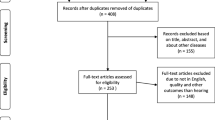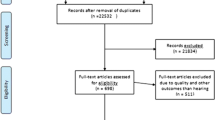Abstract
The study aimed to evaluate the impact of occupational noise on hearing loss among healthcare workers using audiometry. A longitudinal study was conducted with a six-month follow-up period in a hospital with 21 participants, divided into high-noise-exposure (HNE) and low-noise-exposure (LNE) groups. Mean noise levels were higher in the HNE group (70.4 ± 4.5 dBA), and hearing loss was measured using pure-tone audiometry at baseline and follow-up. The HNE group had significantly higher mean threshold levels at frequencies of 0.25 kHz, 0.5 kHz, 4.0 kHz, and an average of 0.5, 1, 2, and 4 kHz (all p-values < 0.05) after the follow-up period. After adjusting for confounding factors, the HNE group had significantly higher hearing loss levels at 0.25 kHz, 0.5 kHz, and average frequencies of 0.5, 1, 2, and 4 kHz compared to the LNE group at the second measurement. Occupational noise levels above 65 dBA over six months were found to cause significant threshold changes at frequencies of 0.25 kHz, 0.5 kHz, and an average of 0.5–4.0 kHz. This study highlights the risk of noise-induced hearing loss among healthcare workers and emphasizes the importance of implementing effective hearing conservation programs in the workplace. Regular monitoring and assessment of noise levels and hearing ability, along with proper use of personal protective equipment, are crucial steps in mitigating the impact of occupational noise exposure on the hearing health of healthcare workers.

Similar content being viewed by others
Data availability
The datasets generated and analyzed during the current study are not publicly available because of confidentiality agreements with participants, but are available from the corresponding author upon reasonable request.
Abbreviations
- CI:
-
Confidence interval
- dBA:
-
A-weighted decibel
- HNE:
-
High noise exposure
- LAeq:
-
A-weighted equivalent continuous sound pressure levels
- LNE:
-
Low noise exposure
- NIHL:
-
Noise-induced hearing loss
- ONIHL:
-
Occupational noise-induced hearing loss
References
Agrawal Y, Platz EA, Niparko JK (2008) Prevalence of hearing loss and differences by demographic characteristics among US adults: data from the National Health and Nutrition Examination Survey, 1999–2004. Arch Intern Med 168:1522–1530
Air-Conduction BP-T (2011) Bone-Conduction Threshold Audiometry with and without Masking: Recommended Procedure. Reading. British Society of Audiology, UK
Al-Rawi NH, Al Nuaimi AS, Sadiqi A, Azaiah E, Ezzeddine D, Ghunaim Q, Abbas Z (2019) Occupational noise-induced hearing loss among dental professionals. Quintessence Int 50:245–250
Ambade B, Sankar TK, Kumar A, Sethi SS (2020) Characterization of PAHs and n-Alkanes in Atmospheric Aerosol of Jamshedpur City, India. J Hazard Tox Radioact Waste 24:04020003
Ambade B, Kurwadkar S, Sankar TK, Kumar A (2021a) Emission reduction of black carbon and polycyclic aromatic hydrocarbons during COVID-19 pandemic lockdown. Air Qual Atmos Health 14:1081–1095
Ambade B, Sankar TK, Kumar A, Gautam AS, Gautam S (2021b) COVID-19 lockdowns reduce the Black carbon and polycyclic aromatic hydrocarbons of the Asian atmosphere: source apportionment and health hazard evaluation. Environ Dev Sustain 23:12252–12271
Ambade B, Sethi SS, Kumar A, Sankar TK, Kurwadkar S (2021c) Health Risk Assessment, Composition, and Distribution of Polycyclic Aromatic Hydrocarbons (PAHs) in Drinking Water of Southern Jharkhand, East India. Arch Environ Contam Toxicol 80:120–133
Ambade B, Sethi SS, Giri B, Biswas JK, Bauddh K (2022a) Characterization, Behavior, and Risk Assessment of Polycyclic Aromatic Hydrocarbons (PAHs) in the Estuary Sediments. Bull Environ Contam Toxicol 108:243–252
Ambade B, Sethi SS, Kurwadkar S, Mishra P, Tripathee L (2022b) Accumulation of polycyclic aromatic hydrocarbons (PAHs) in surface sediment residues of Mahanadi River Estuary: Abundance, source, and risk assessment. Mar Pollut Bull 183:114073
Ambade B, Sethi SS, Chintalacheruvu MR (2023) Distribution, risk assessment, and source apportionment of polycyclic aromatic hydrocarbons (PAHs) using positive matrix factorization (PMF) in urban soils of East India. Environ Geochem Health 45:491–505
Basner M, Babisch W, Davis A, Brink M, Clark C, Janssen S, Stansfeld S (2014) Auditory and non-auditory effects of noise on health. Lancet 383:1325–1332
Campo P, Lataye R, Loquet G, Bonnet P (2001) Styrene-induced hearing loss: a membrane insult. Hear Res 154:170–180
Chen S-M, Fan Y-T, Martinez RM, Chen C (2023) Noise-induced hearing loss profile among Taiwan Airforce on duty pilots. Am J Otolaryngol 44:103802
Chou CW, Chen YY, Wang CC, Kao TW, Wu CJ, Chen YJ, Zhou YC, Chen WL (2020) Urinary biomarkers of polycyclic aromatic hydrocarbons and the association with hearing threshold shifts in the United States adults. Environ Sci Pollut Res 27:562–570
Chung DY, Willson GN, Gannon RP (1983) Lateral differences in susceptibility to noise damage. Audiology 22:199–205
Ciorba A, Bianchini C, Pelucchi S, Pastore A (2012) The impact of hearing loss on the quality of life of elderly adults. Clin Interv Aging 7:159–163
Cruickshanks KJ, Wiley TL, Tweed TS, Klein BE, Klein R, Mares-Perlman JA, Nondahl DM (1998) Prevalence of hearing loss in older adults in Beaver Dam, Wisconsin: The epidemiology of hearing loss study. Am J Epidemiol 148:879–886
Deng X-F, Shi G-Q, Guo L-L, Zhu C-A, Chen Y-J (2019) Analysis on risk factors of depressive symptoms in occupational noise-induced hearing loss patients: A cross-sectional study. Noise Health 21:17
Frye MD, Ryan AF, Kurabi A (2019) Inflammation associated with noise-induced hearing loss. J Acoust Soc Am 146:4020–4032
Gladd DK, Saunders GH (2011) Ambient noise levels in the chemotherapy clinic. Noise Health 13:444–451
Haile LM, Kamenov K, Briant PS, Orji AU, Steinmetz JD, Abdoli A, Abdollahi M, Abu-Gharbieh E, Afshin A, Ahmed H (2021) Hearing loss prevalence and years lived with disability, 1990–2019: findings from the Global Burden of Disease Study 2019. Lancet 397:996–1009
Hawkins JE Jr (1971) The role of vasoconstriction in noise-induced hearing loss. Ann Otol Rhinol Laryngol 80:903–913
Henderson D, Bielefeld EC, Harris KC, Hu BH (2006) The role of oxidative stress in noise-induced hearing loss. Ear Hear 27:1–19
Jansen EJM, Helleman HW, Dreschler WA, de Laat JAPM (2009) Noise induced hearing loss and other hearing complaints among musicians of symphony orchestras. Int Arch Occup Environ Health 82:153–164
Katzenell U, Segal S (2001) Hyperacusis: review and clinical guidelines. Otol Neurotol 22:321–6 (discussion 326-327)
Kurabi A, Keithley EM, Housley GD, Ryan AF, Wong AC-Y (2017) Cellular mechanisms of noise-induced hearing loss. Hear Res 349:129–137
Lewkowski K, Heyworth JS, Li IW, Williams W, McCausland K, Gray C, Ytterstad E, Glass DC, Fuente A, Si S (2019) Exposure to noise and ototoxic chemicals in the Australian workforce. Occup Environ Med 76:341–348
Li W, Chen D, Ruan W, Peng Y, Lu Z, Wang D (2022) Association of polycyclic aromatic hydrocarbons exposure, systemic inflammation with hearing loss among adults and adolescents. Environ Pollut 296:118772
Lin FR (2012) Hearing loss in older adults: who’s listening? JAMA 307:1147–1148
Linssen AM, van Boxtel MP, Joore MA, Anteunis LJ (2014) Predictors of hearing acuity: cross-sectional and longitudinal analysis. J Gerontol A Biol Sci Med Sci 69:759–765
Martin RH, Gibson ES, Lockington JN (1975) Occupational Hearing Loss Between 85 and 90 dBA. J Occup Environ Med 17:13–18
Moselhi M, El-Sadik YM, El-Dakhakhny A (1979) A six-year follow up study for evaluation of the 85 dBA safe criterion for noise exposure. Am Ind Hyg Assoc J 40:424–426
Pollarolo M, Immordino A, Immordino P, Sireci F, Lorusso F, Dispenza F (2022) Noise-Induced Hearing Loss in Police Officers: Systematic Review. Iran J Otorhinolaryngol 34:211
Puel J-L, Ruel J, d’Aldin CG, Pujol R (1998) Excitotoxicity and repair of cochlear synapses after noise-trauma induced hearing loss. NeuroReport 9:2109–2114
Sheikh MS, Majeed S, Ali S (2020) Noise induced hearing loss among industrial workers of South Punjab, Pakistan. Professional Med J 27:1022–1026
Siegel MG (2019) The risk of noise-induced hearing loss performing knee replacement surgery. Noise Health 21:183
Sliwinska-Kowalska M (2020) New trends in the prevention of occupational noise-induced hearing loss. Int J Occup Med Environ Health 33:841–848
Somma G, Pietroiusti A, Magrini A, Coppeta L, Ancona C, Gardi S, Messina M, Bergamaschi A (2008) Extended high-frequency audiometry and noise induced hearing loss in cement workers. Am J Ind Med 51:452–462
Ullah R, Bailie N, Crowther S, Cullen J (2004) Noise exposure in orthopaedic practice: potential health risk. J Laryngol Otol 118:413–416
Wang Q, Wang X, Yang L, Han K, Huang Z, Wu H (2021a) Sex differences in noise-induced hearing loss: a cross-sectional study in China. Biol Sex Differ 12:1–10
Wang Q, Yang L, Qian M, Hong Y, Wang X, Huang Z, Wu H (2021b) Acute recreational noise-induced cochlear synaptic dysfunction in humans with normal hearing: a prospective cohort study. Front Neurosci 15:659011
Wang T-C, Chang T-Y, Tyler RS, Hwang B-F, Chen Y-H, Wu C-M, Liu C-S, Chen K-C, Lin C-D, Tsai M-H (2021c) Association between exposure to road traffic noise and hearing impairment: a case-control study. J Environ Health Sci Eng 19:1483–1489
Willett K (1991) Noise-induced hearing loss in orthopaedic staff. J Bone Joint Surg Br 73:113–115
Zare S, Ghotbi-Ravandi MR, ElahiShirvan H, Ahsaee MG, Rostami M (2019) Predicting and weighting the factors affecting workers’ hearing loss based on audiometric data using C5 algorithm. Ann Glob Health 85:88
Zaw AK, Myat AM, Thandar M, Htun YM, Aung TH, Tun KM, Han ZM (2020) Assessment of noise exposure and hearing loss among workers in textile mill (Thamine), Myanmar: a cross-sectional study. Saf Health Work 11:199–206
Acknowledgements
None
Funding
The authors declare that no funds, grants, or other support were received during the preparation of this manuscript.
Author information
Authors and Affiliations
Contributions
Tang-Chuan Wang and Ta-Yuan Chang contributed to study conception and design. Material preparation, data collection and analysis were performed by Tang-Chuan Wang, You-Cheng Yu, Jia-Yi Lin, and Alan Hsu. Tang-Chuan Wang and Ta-Yuan Chang wrote the first draft of the manuscript. Yung-An Tsou, Chiu-Shoung Liu, Kai-Jen Chuang, Wen-Chi Pan, Chin-An Yang, Sung-Lin Hu, Chien-Yi Ho, Tzu-Liang Chen, Chia-Der Lin, and Pei-Ying Pai commented on the previous versions of the manuscript and made critical revisions. All the authors have read and approved the final version of the manuscript.
Corresponding author
Ethics declarations
Ethical approval
The study protocol was reviewed and approved by the Institutional Review Board of China Medical University Hospital, Taichung, Taiwan (no. CMUH108-REC1-054).
Consent to participate
Informed consent was obtained from all individual participants included in the study.
Consent to publish
Not applicable.
Competing interests
The authors have no relevant financial or non-financial interests to disclose.
Additional information
Responsible Editor: Lotfi Aleya
Publisher's Note
Springer Nature remains neutral with regard to jurisdictional claims in published maps and institutional affiliations.
Rights and permissions
Springer Nature or its licensor (e.g. a society or other partner) holds exclusive rights to this article under a publishing agreement with the author(s) or other rightsholder(s); author self-archiving of the accepted manuscript version of this article is solely governed by the terms of such publishing agreement and applicable law.
About this article
Cite this article
Wang, TC., Yu, YC., Hsu, A. et al. Impact of occupational noise exposure on the hearing level in hospital staffs: a longitudinal study. Environ Sci Pollut Res 31, 24129–24138 (2024). https://doi.org/10.1007/s11356-024-32747-7
Received:
Accepted:
Published:
Issue Date:
DOI: https://doi.org/10.1007/s11356-024-32747-7




